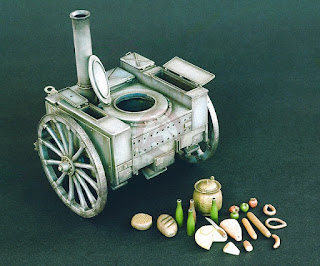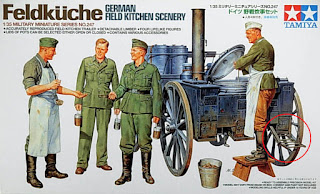The Canon de 155 Long was a fortress gun developed in the period after the Franco-Prussian War by the aptly named Charles de Bange. The gun saw use in WWI with the French, and later in WWII with the Finns.
I picked up the Wespe (ex-Retrokit?) model because I liked the look of the gun, particularly with the cingoli tracks on the wheels. The model is made of a decent resin that is not as brittle as the type that is typically favored by a lot of European manufacturers.
The parts were largely free of flash and had few bubbles, however, several of the track links for the cingoli were either not fully cast or broken.
Part 15 was mislabeled in the original instructions. It is correctly identified in my version of the parts breakdown. The former part 15 is now labeled part 28, but the kit only provides one piece instead of the required two pieces. The original instructions do not even indicate how this piece(s) is supposed to be used.
There are additional errors in the instructions, and the assembly guidelines definitely need to be fleshed out a little better. I recommend breaking the build into three separate steps: cannon, wheels, and carriage.
Cannon assembly is pretty straight forward. Part 22 is a lift ring for the 1916 version barrel, so the original lift ring must be removed if you want to use this one.
Part 28 fits onto the trunnion, and should not be glued. Wespe put their display model together using part 22 instead of part 28, or maybe they had part 22 on one side, and part 28 on the other.
Since I only had one piece, I made do with some scratch built parts. The ends of the trunnions were made flush with the carriage, but not all guns appeared this way. Many had the ends of the trunnions protruding from the sides.
It's probably a good idea to delaying the gluing of parts 18 and 21 until you are ready to attach the barrel to the carriage. I'm thinking some modification of part 18 may be necessary if you want to display the barrel in elevated position.
I'm not sure how exactly the lower ends of part 21 are supposed to be affixed to part 18. The instructions are unclear, but I did the best I could based on limited photographic references.
I added the rivet holding the reinforcing ring together to my model, but it does not seem to be present on most guns.
The most time consuming part of the build was with the cingoli. When I assembled the kit, I made the mistake of just gluing the track links to the wheels without first doing a test fit. I ended up having to shorten several of the tracks to make all the links fit.
The correct way to assemble the links requires that they be arranged loosely, instead of fitting tightly around the wheels.
Another issue is that many models of the 155 mle. 1877 (including the picture of the built model on the Wespe box) show the cingoli with 11 track shoes. I ended up fitting 11 shoes as well, but I think that there should actually be 12 track shoes. The kit supplies enough pieces for adding 12 shoes, but I'm not really sure if this is possible to do without making the cingoli overly loose.
The carriage goes together in a straightforward manner, though there is a mystery part 16 which looks like some sort of rod. The actual part 16 is a cannon shell without the fuse, so I just ignored this particular step.
The carriage has a square port on the front which I have not seen in any pictures of the actual gun, although I have to admit there are not many pictures showing the front of the gun.
I couldn't find any pictures of cannons with anything like part 23 on the carriage trail, but I attached it anyway. Leaving it off is probably okay though.
I used part 11 on my carriage since part 27 was damaged. I've also seen pictures of guns with two platforms mounted on the trail.
 |
| First Legion 1/30 155mm 1877/1914 L de Bange Cannon |
For part 13, I glued them at the more forward position, but the majority of pictures seem to show these brackets in the more rearward position.
I'm not particularly happy with the model I built, but I guess it looks fine if you don't know too much about the actual cannon.











































